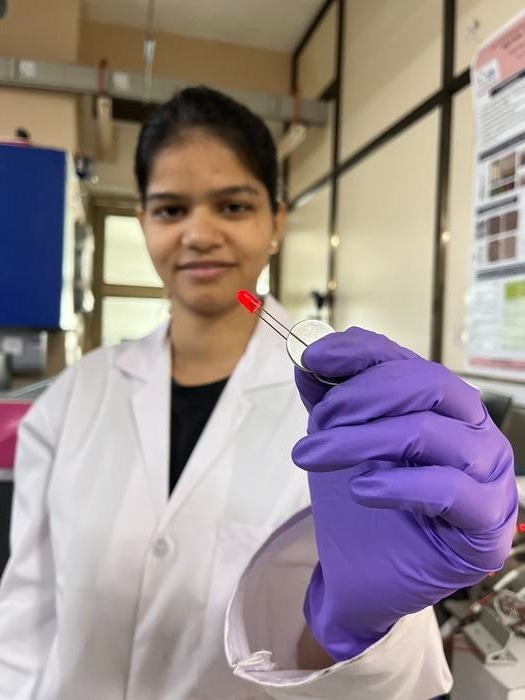Reviewed by Lexie CornerMar 21 2024
Lithium metal batteries (LMBs) have an energy density ten times higher than current lithium-ion batteries (LIBs). They have thus been identified as one of the potential future storage systems. Nevertheless, LMBs cannot be utilized for fast-charging applications and pose certain safety issues. Uncontrolled dendrite development is a major obstacle to its progress, as it can cause excessive heating and battery short circuits.

Preeti Yadav (author) holding a glowing red LED (3V) powered by the modified separator-based lithium metal battery. Image Credit: Dr. Pallavi Thakur and Prof. T. N. Narayanan
Researchers have previously attempted to solve safety problems with LMBs, but their techniques were laborious and costly/time-consuming. T. N. Narayanan's team at the Tata Institute of Fundamental Research, Hyderabad (TIFRH) presents a simple, scalable, and cost-effective approach to building a safer, more durable lithium metal battery.
In a battery, a porous separator membrane separates the electrodes and prevents a short circuit. When a battery is operated for an extended period of time, whisker or tree-like structures called dendrites begin to develop on one of the electrodes. If these dendrites develop uncontrollably, they may eventually form a physical bridge between the two electrodes, resulting in a short circuit.
The study’s lead authors, graduate students Preeti Yadav and Pallavi Thakur, modified the separator membrane in a conventional battery using a commercially available graphite derivative powder. This adjustment reduces dendrite growth and significantly increases the battery’s lifespan. The researchers argue that this approach of separator modification offers tremendous potential to be scaled up for industrial utilization.
However, with a very high current density of 10 mA cm-2, the battery appears to deteriorate gradually. This might be attributed to lithium electroplating on carbon (a component of the deposited graphite derivative layer). The researchers want to look into these issues further and understand the significance of interfaces in increasing battery performance from a fundamental standpoint.
Journal Reference:
Yadav, P., et al. (2024) High Rate, Dendrite Free Lithium Metal Batteries of Extended Cyclability via a Scalable Separator Modification Approach. Small. doi:10.1002/smll.202308344